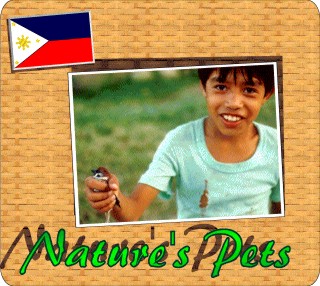
(Insects & Animals)

Growing up in the Philippines, Karen and Kathy experienced a variety of insect and small animal life surpassed only by the variety of the fruits that grew around them. Some of these life forms were scary or painful, like the small red ants whose bite was like a sting, and others were to be played with, like the fireflies they would catch in their hands at night.
 (Flying Cockroaches)
(Flying Cockroaches)
Ipis are flying cockroaches about an inch long with rounded bodies (longer and fatter than most American cockroaches). They fly and crawl throughout the households and are often not afraid of humans. The bravery of an ipis was shown to be stronger than a human's time and again when the person in the path of an ipis's flight would duck before the ipis would veer from its course.
 (Dragonflies)
(Dragonflies)
Tutubis are dragonflies, and are often made into play things for the children of the provinces. These children will tie a string around the tutubi and have them fly like a dog on a leash. Sometimes the children cut off the tutubi's wings and put them in a jar or on a spider's web so they can watch them before they die. The tutubing karayom (needle dragonfly) is a baby tutubi which looks similar to a needle with wings. The biggest adults are called tutubing kalabaw (water buffalo dragonfly) and are the most difficult to catch.
 (Lizards)
(Lizards)
Butiki are small, brownish-white lizards. The can be seen at night, sometimes during the day, usually on porch ceilings. They often congregate near a light so they can eat the mosquitoes attracted to the brightness. Sometimes they walk in such a way that their body makes a "C" and then an inverted "C" with every step with their front and back pairs of legs extending perpendicularly from either end of the "C." Kambal would be frightened by the cold touch of the butiki when the occasional one would fall from the ceiling onto them. Sometimes they would be accidentally smashed in a door jam but Kambal would not realize it until a smell started to emanate from the door some days later.
 (Geckos)
(Geckos)
Tuko is an onomatopoetic term for the gecko which was found in Maahas when Kambal was living there. Like the butiki, tuko are usually seen at night. There is a game played by children based on the number of "tukos" the gecko makes: if the sound is heard an odd number, it is said that it will rain the following day; and if it is even it is believed it won't rain. Tukos could not be found in 1995 when the twins returned probably due to the collateral effects of the development which had occurred during the intervening years bringing with it a higher concentration of people, cars, noise, and building.
 (Large Lizards)
(Large Lizards)
Also suspiciously absent from Maahas were the bayawak, lizards that grow about three feet long. Kambal had two bayawak living on the roof of their house and above the ceiling in their kitchen. These bayawak could occasionally be seen where the ceiling buckled down and there was an open from which their tails would hang out. One of the girls would grab an ipil-ipil stick or bamboo stick and hit the ceiling to scare the lizards back into hiding. They suspected that the bayawak ate the mice that were found in the kitchen and sometimes on the patio outside the kitchen.
 (Ducks)
(Ducks)
Itik are ducks that are raised exclusively for their eggs. The eggs of the itik are sold primarily for balot, developed embryonic eggs. One itik farm in Maahas has three itik buildings (maybe 900-square feet) where 2,000 eggs are produced daily. Balot that goe unsold are then sold as "day old" eggs.
 (Pigs)
(Pigs)
Ever popular and culturally important baboy (pigs) can mate at seven months old. When in heat, the pig's vaginal area becomes swollen and red and a barako (a male pig) can be hired for P300. Gestation is 114 days, and a 45 day old piglet can sell for P1200.
 (Goats)
(Goats)
Kambing (goats) are domesticated and are seen on the sides of roads, on the roads, and in fields eating anything. Kambing are eaten only on special occasions, like weddings, birthdays, and fiesta.
 (Cats & Dogs)
(Cats & Dogs)
I saw only a few pusa (cats) while in the Philippines, but numerous aso (dogs). Cats aren't very popular as pets because their so agile and can easily get food from atop a refrigerator and other places. Dogs in the province eat unwanted scraps of food rather than "dog food" because people are poor. It is probably because of this, that dogs aren't pets in same sense of a pet in the comparatively fat, ostentatious America, and it is unusual to see one being petted. It is also a rare sight to see a dog whose breed is identifiable in a place that is home to the universally thin, and some of the mangiest, dogs in the world. When they were growing up in Maahas, kambal would avoid walking in unfamiliar places out of fear that they might happen across hostile dogs. Prior to visiting the Philippines, our Filipino friends who had recently visited themselves warned us about the dogs and told us how to react to a charging dog. They said, "bend over as if to pickup a stone with which to throw at the dog and the dog will leave you alone." As it turned out, we didn't walk in the path of any dogs that did more than give a mean bark to us.
 (Special Snacks)
(Special Snacks)
On occasion men will get together for informal, Friday-night drinking parties where pulutan is served. Pulutan is merely a snack, but the particular pulutan served at these drinking parties is sometimes dog meat. One of kambal's friends lives in a compound of sorts where one of the many dogs is reputed to have bitten several visitors. It is a wonder that one of the visitors haven't yet returned the favor and offered the transgressor to friends on a Friday night.

 (Birds)
(Birds)
Young boys in Laguna can be seen walking through the streets with birds (often doves) which they have captured. These birds they throw into the air after a short time and then clap their hands to see if the bird will come back.
 (Cockfighting)
(Cockfighting)
In the Philippines, roosters can be seen, and heard everywhere attesting to the popularity of sabong (cockfighting and gambling on cockfighting). Cocks can fight at nine months old, but it is said to be best to wait until they mature to eighteen months-two years, the older the better. Men can be seen throughout the Philippines holding, stroking ther cocks. I saw one sabongero practicing with his cocks in this way: one cock was tied to the ground (as they often are to keep them from going astray) while he held another by the tail and let the second cock get close enough to the tied up one for both of their neck feathers to stand up (signifying aggression), but far enough away so they could not peck each other. Boxing, or practice sabong, is held on the street. The cocks have littel boxing gloves wherey they will someday have a tari, a razor-sharp blade, tied to the back of their talon. Bigger cocks always win so when the sabongeros match up their cocks before a fight, determining relative size is crucial. Cockfighting is held at a sabongan. The sabongan in Los Baņos is Lapiz Coliseum. Sabongeros are admitted free with their roosters. We were told by one of the spectators/gamblers that the American roosters, called Texas, are good at fighting on the ground, but the wild Tagalog roosters are better at fighting in the air so some say it is best to cross-breed the two to obtain the best fighting cock. Kristos take bets for big betters so the common better bets against each other and against the kristos. Betting usually begins at P50. In a fight, the cocks are taken apart up to two times when they have stopped fighting before the cock who stops pecking is declared the looser, but just as often the looser is the one who falls to the ground. The losing cock is boiled, dead or alive, and given to the winning sabongero to eat. The winning, injured cocks are sewn up in stalls behind the bleachers. (Sabong is the refuge of men, but hweteng, a lottery where two numbers are chosen, is played by both women and men).

